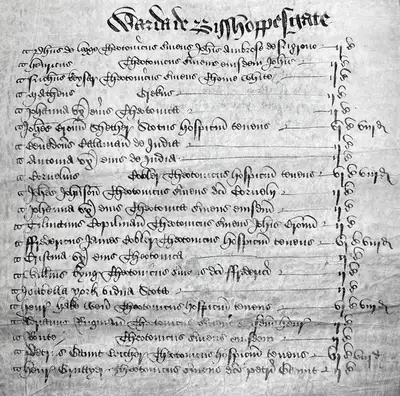Record revealed
List of immigrant Londoners from 1483
This 15th-century list of ‘alien’ residents, gathered for tax purposes, gives us a remarkable insight into London’s medieval immigrant population.
Images
Image 1 of 3

The list of names starts here in the document. It states that it is a record of ‘personarum extranaorum’, foreign people, who live ‘infra civitate London et suburbiis’, in the city of London and its suburbs. The list then starts with ‘Wardia Turris London’, the ward or city district of the Tower of London.
Image 2 of 3

The list of resident immigrants here is for Bishopsgate ward. It includes Matthew the Greek (fourth down) and his German wife Johanna (fifth down). Johanna is described as ‘theotonica’, teutonic. Under Johanna, John Broun is a Scottish ‘shether’, making sheaths for swords. Benedict Calaman ‘de India’ and Antonia his wife are seventh and eighth on this list.
Image 3 of 3

Nichodeus Trumpet, Romanus (from Rome), is second from the bottom of this list of alien residents of Cornhill ward.
Why this record matters
- Date
- 27 April 1483
- Catalogue reference
- E 179/242/25
In Bishopsgate Ward in 1483, Matthew the Greek and his German wife Johanna lived alongside their Scottish neighbour John Broun, who made sheaths for swords. Benedict Calaman and his wife Antonia had travelled from much further afield – the tax record describes them as ‘de India’, from India. Elsewhere in London, Lombards (from what is now northern Italy) and Icelanders rubbed shoulders with Picards (from what is now northern France) and Danes.
The National Archives has this detailed picture of foreign-born residents of London for tax reasons. In 1483, the Crown took an inquest of the City of London and the surrounding areas to find out who was liable to pay the ‘alien subsidy’. This tax was a two-shilling payment from every first-generation immigrant to the Crown, first granted to King Henry VI in 1440. Justices of the Peace and juries of local men were tasked with collecting the names of first-generation immigrants in their area who were subject to the tax.
The list of names, and in some cases occupations, gives us a sense of the diversity of medieval London. It includes 1,595 foreign-born individuals who were subject to the tax.
However, this extensive list only covers some of the immigrants in medieval London. Some notable immigrant communities successfully petitioned the Crown for an exemption from the tax. Italian merchants, Hanseatic merchants (members of the Northern European Hanseatic League, predominantly of German origin), and Castilian (Spanish) merchants were all exempt, as were those French people from parts of France that had formerly been subject to the English Crown, for example Normandy. Considering all of these people, the resident immigrant population of London at this time was around 6% of the city's population.
Sometimes, these tax records are the only record we have of these people. For Benedict and Antonia, we can only speculate why and how they came to London and whether they came from what we would now recognise as India or somewhere else to the east of the Mediterranean.
In some cases, though, we have other traces of these foreign-born residents in the archives. For example, the Roman Nichodeus Trumpet was, as his name suggests, a trumpeter. In the Great Wardrobe account with the costs for Richard III’s coronation, which took place on 6 July 1483, we have a record of a minstrel called Nichodemus being granted red cloth to make new clothes for his participation in the ceremony.
